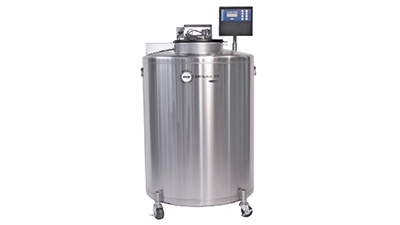Cryo Preservation

Cooling and freezing of biological materials is a complex process. This is due to the chemical and physiological process that takes place when material is cooled. Proper maintenance and handling of biological materials is critical to ensure their continued stability at low temperatures. Since biological materials vary, an important aspect of setting up and operating an effective bio-repository is an understanding of the materials to be maintained. While biological materials can be preserved by several means, low-temperature storage is the only preservation method that minimizes changes in the material. Cryopreservation has been used for decades to ensure the maintenance of living cells and organisms.
Once biological materials are properly cryo-preserved, there is virtually no risk of change if they are properly maintained.
Proper maintenance requires assuring a constant critical temperature. From a good practice point of view, safety margins and modes of failure are also important and very worthy of consideration. Safety margins and critical temperatures are vital considerations. Initially it is important to realize that once a substance is in the solid phase (i.e., frozen); there is no such thing, in terms of cryobiology, as too cold. There is no state below solid; further cooling simply reduces the energy for every degree it is cooled, otherwise it may cause structural changes. Secondly, it is vital to appreciate that the critical temperature for long term viability of the sample will be, in many cases, a temperature far below the nominal fusion temperature. In other words, keeping the sample frozen simply is not sufficient.
All biological materials deteriorate over time - this is an unavoidable physical phenomenon.
When the need to study and/or store biological materials arises, a long-term reliable storage solution is needed; cryopreservation is the answer. When exploring cryopreservation as a storage solution, many factors must be considered, including, but not limited to: Critical Temperature, Storage Phase, and Capacity. MVE offers a complete line of storage solutions in liquid or vapor, with temperatures ranging from -125°C to -190°C.
Understanding the materials to be stored is vital to determining the critical temperature.
Most biological materials must be stored below the Glass Transition of Water (Tg) before long term degradation is minimized. The value of Tg is most commonly agreed to be between -130 °C and -135 °C. Storage above this temperature will result in poor long term viability of samples. Storage conditions that transition above and below this value will accelerate degradation of samples. Knowing this, one can make the conclusion that colder is better. All MVE freezers are created to maintain the coldest and most consistent temperature in their designed operating ranges. Many models can maintain near liquid nitrogen temperature in the warmest part of the freezer, minimizing transient temperature conditions.
Determining the phase of storage is nearly as critical as determining the proper storage temperature.
Storing in liquid phase provides the longest possible hold time and coldest possible temperature. Vapor storage minimizes the possibility of cross contamination and exposure of samples to liquid nitrogen. MVE provides a complete line of freezers that can meet any storage solution in liquid or vapor.
Selecting the proper size freezer is important to ensuring the long term efficiency and cost effectiveness of the repository.
MVE offers the widest, most complete product line in the world and can meet the needs of the small research laboratory as well as the largest long term repository. Linde can help you select a freezer that is large enough to meet your current needs and provide room for growth.
Use our Cryogenic Product Selector Guide for help or contact our Specialty Gas Technical Support who can provide you with answers and recommendations. Please call 1-877-772-9247 or email us.




























